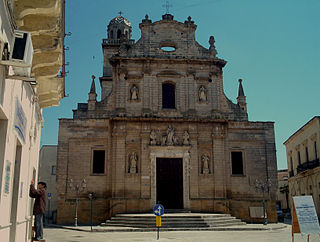Related Research Articles

Italo Calvino was an Italian writer and journalist. His best-known works include the Our Ancestors trilogy (1952–1959), the Cosmicomics collection of short stories (1965), and the novels Invisible Cities (1972) and If on a winter's night a traveler (1979).

Kinder Surprise, also known as Kinder Egg or Kinder Surprise Egg, is a milk chocolate consisting of a chocolate egg surrounding a yellow plastic capsule with a small toy inside. Manufactured by the Italian company Ferrero since 1974, it was co-created by Michele Ferrero and William Salice, and is one of several candies sold under the Kinder brand. Kinder Surprise was originally created with children in mind, replicating an Italian Easter family tradition in which adults give children large chocolate eggs with toys inside. However, Kinder Surprise toys have become collectible for adults as well. Since 1974, 30 billion Kinder Surprise eggs have been sold worldwide.

Aron Hector Schmitz, better known by the pseudonym Italo Svevo, was an Italian and Austro-Hungarian writer, businessman, novelist, playwright, and short story writer.
Italo disco is a music genre which originated in Italy in the late 1970s and was mainly produced in the 1980s. Italo disco evolved from the then-current underground dance, pop, and electronic music, both domestic and foreign and developed into a diverse genre. The genre employs electronic drums, drum machines, synthesizers, and occasionally vocoders. It is usually sung in English, and to a lesser extent in Italian and Spanish.

Negroamaro is a red wine grape variety native to southern Italy. It is grown almost exclusively in Apulia and particularly in Salento, the peninsula which can be visualised as the "heel" of Italy. The grape can produce wines very deep in color. Wines made from Negroamaro tend to be very rustic in character, combining perfume with an earthy bitterness. The grape produces some of the best red wines of Apulia, particularly when blended with the highly scented Malvasia Nera, as in the case of Salice Salentino.
In historical linguistics, Italo-Celtic is a hypothetical grouping of the Italic and Celtic branches of the Indo-European language family on the basis of features shared by these two branches and no others. There is controversy about the causes of these similarities. They are usually considered to be innovations, likely to have developed after the breakup of the Proto-Indo-European language. It is also possible that some of these are not innovations, but shared conservative features, i.e. original Indo-European language features which have disappeared in all other language groups. What is commonly accepted is that the shared features may usefully be thought of as Italo-Celtic forms, as they are certainly shared by the two families and are almost certainly not coincidental. The archaeological horizon with which a hypothetical Italo-Celtic language family is often associated, before the split between Italic and Celtic languages, is that of the Bell Beaker culture.

Salice Salentino is a small town and comune in the southern part of Apulia, Italy, in the Salento area. It is bounded with the province of Taranto to the northwest and the province of Brindisi to the north.
The Battle of the Willows (377) took place at a place called ad Salices, or according to Ammianus, a road way-station called Ad Salices ; probably located within 15 kilometres of Marcianople, although its exact location is unknown. Forces from the Western Roman Empire under the command of Richomeres advanced westward, while forces of the eastern Roman Empire under Traianus and Profuturus advanced northward where they joined forces to attack the Goths who had recently rebelled under command of Fritigern. and were laying waste to the northern Balkans.

Sauze d'Oulx is a town and comune in the Metropolitan City of Turin, Piedmont located 80 km from Turin in the Val di Susa, at the foot of Monte Genevris.

Cressing is a village and civil parish in the Braintree district of Essex, England. Within the parish is the village of Tye Green and the hamlet of Hawbush Green.

Guagnano is a town and comune in the province of Lecce, Apulia, south-eastern Italy. Situated in northern Salento, it also includes the fraction of Villa Baldassarri.
Velhe is a town and comune in the Italian province of Lecce in the Apulia region of south-east Italy. Veglie is 20 kilometres (12 mi) west of Lecce and 12 kilometres (7 mi) east of the sea, the Gulf of Taranto. It is bounded by the comuni of Campi Salentina, Carmiano, Leverano, Nardò, Novoli and Salice Salentino.

Godiasco Salice Terme is a comune (municipality) in the Province of Pavia in the Italian region Lombardy, located about 60 km south of Milan and about 30 km south of Pavia.

Salice is a commune in the Corse-du-Sud department of France on the island of Corsica.

The Italo-Albanian Catholic Church or Italo-Albanian Byzantine-Catholic Church is one of the 23 Eastern Catholic Churches which, together with the Latin Church, compose the Catholic Church. It is an autonomous (sui juris) particular church in full communion with the Pope of Rome, directly subject to the Roman Dicastery for the Oriental Churches, but which follows the Byzantine Rite, the ritual and spiritual traditions that are common in most of the Eastern Orthodox Church. It uses two liturgical languages: Koine Greek, the traditional language of the Eastern Churches, and Albanian, the native language of most of its adherents.
The Italo-Dalmatian languages, or Central Romance languages, are a group of Romance languages spoken in Italy, Corsica (France), and formerly in Dalmatia (Croatia).
Salice Salentino is an Italian wine produced primarily from the Negroamaro grape in the area surrounding the municipality of Salice, in Apulia. The wine received DOC status in 1976. Chiefly known as a red wine, it also exists as a white and rosé.

William Salice was an Italian businessman. He was employed at Ferrero SpA, where he was credited as the inventor of Kinder Eggs.
Karl Otto von Seemen was a German botanist and horticulturalist. He is noted for his studies of plants in the south of Africa.
Pier Giuseppe Gurgo-Salice (1894–1974), generally credited as Pierre Gurgo-Salice, was an Italian film producer. He was a senior figure at Lux Film, an Italian film production company that specialised in co-productions with France where Lux had a subsidiary. His brother Ermanno Gurgo-Salice headed production in France.
References
- ↑ "Italo Salice". Olympedia. Retrieved 18 May 2020.